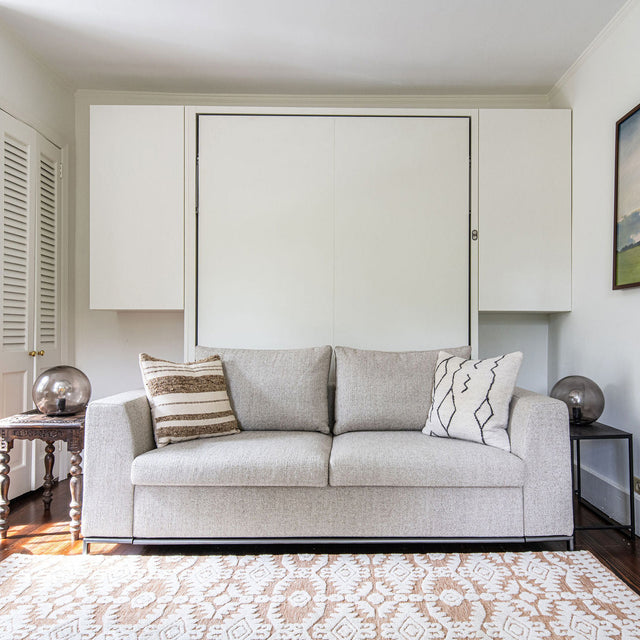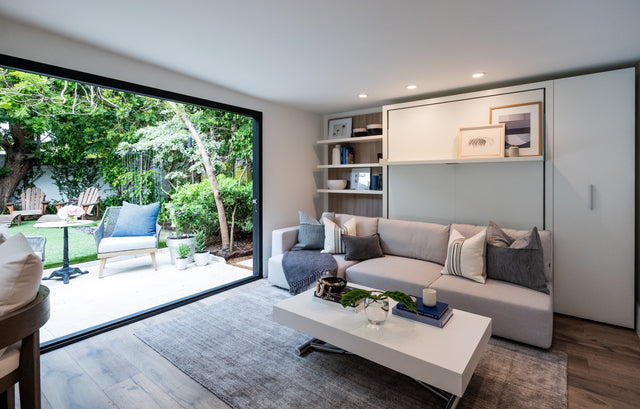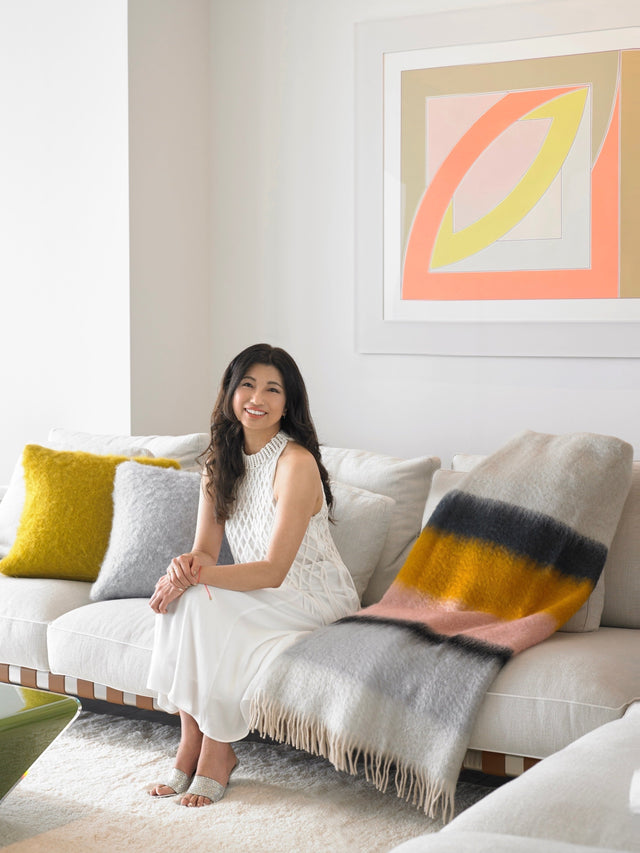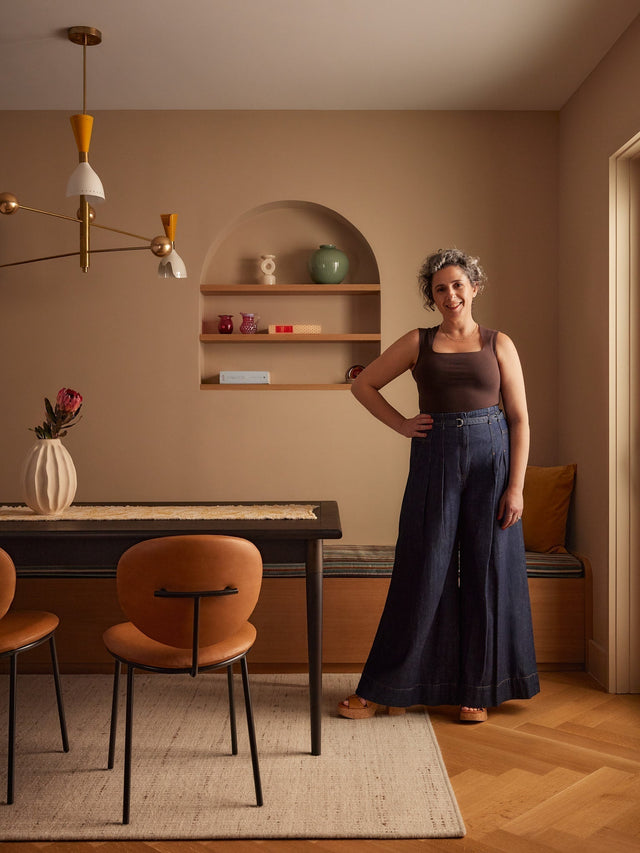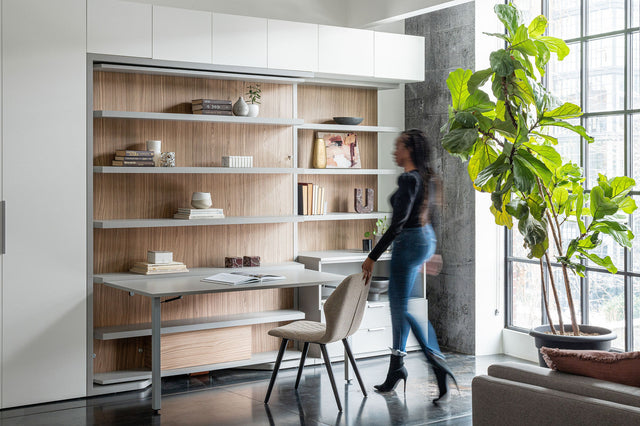Wall Bed Style Guide
Wall Beds Come in a Variety of Sizes
Wall beds are so much more than simple platforms that fold down from the wall. Modern designs integrate shelving, desks, tables, and seating, so the system maximizes space and functionality. From varying sizes to a wide range of styles, wall beds can work with any home. Explore our wall bed design inspiration ideas to envision a Murphy bed addition to your home.

Sizes of Wall Beds
Just like a regular bed, wall beds come in a variety of sizes to fit your needs and available space. When choosing a size, consider who will use the bed and how often it will be used. Is it a bed for a small child, one adult, or a couple? Are you purchasing a bed for use every night or for occasional overnight visitors? How much space do you need to sleep comfortably?
Measuring the available space is another important step in choosing the size. A Murphy bed is a space saver when it is folded up, but you need enough space for the bed to fold down fully and have an area for walking around the bed. Take measurements of the area where you plan to place the bed and measure out the dimensions of the extended bed itself. That way, you can get an accurate idea of how it will look and fit in your space.
Wall beds typically come in the following sizes:
- Twin: A twin (or single) wall bed is perfect for a child’s bedroom with limited space. This size offers plenty of sleeping space for a young child without taking up a lot of floor space when it is extended. Twin wall beds also work when you need a single sleeping spot, but space is very limited. For example, you might add it to a tiny home office to accommodate a single overnight guest. A single adult can sleep in a twin bed, although some might prefer more sleeping space.
- Queen: Wall beds come in the traditional queen size when you want to accommodate two adults comfortably. If you choose a queen size wall bed, make sure you have enough floor space for the extended size. This option is perfect for every night use or as a guest bed when you want two guests to sleep comfortably.
- Bunk Beds: If floor space is limited, consider a bunk bed version of wall beds. You get the functionality of bunk beds with the space-saving wall bed design. This solution is ideal for a shared bedroom. Murphy bunk beds also work well when your child has a sleepover. The second bed provides a comfortable place for a slumber party guest to sleep.
Murphy Bed Orientation Options
All wall beds swing up and down easily, regardless of orientation option.
Murphy beds come with two orientation options: hinging vertically (from the end) or hinging horizontally (from the side). The setup of your room is the main factor in deciding which orientation is best for you. Both options let you tuck the bed away during the day, so the primary consideration is how the bed looks and fits in your space when folded down.
A bed that hinges vertically creates a traditional look when folded down. The wall above the bed acts as a headboard, especially when you choose design elements that have a framing effect. One consideration with this style of Murphy bed is how far it sticks out into the space. Because the short end attaches to the wall, the bed extends out into the middle of the space. In a large room without a lot of other furniture, this isn’t an issue. If you have a small area with other furniture pieces, space may be tight with the bed fully extended. A bed hinging horizontally, however, takes advantage of wall space to minimize how far it sticks out into the room.

All wall beds swing up and down easily, regardless of the orientation. The beds use a counterweight method to keep the bed open or closed. They move up and down with little effort whether attached by the end or side.
Wall Bed Incorporation Ideas
Wall bed ideas range from seamless integration that you don’t notice to creating a focal point on the wall, depending on your preferred look. Many design options incorporate different functionalities, such as seating or storage. When deciding how to incorporate the bed into the room, think about how you want to use the space overall and what extra functions might benefit the space. Some of the options include:
- Seamless integration into the wall: This option is ideal when you want the wall bed to blend into the wall without being noticed. The bed seems to disappear into the wall for minimal disruption in the existing room design.
- Shelving or storage integration: Shelving or storage added to the wall bed capitalizes on the setup to maximize space. Some designs incorporate shelving around the wall bed to create a built-in effect when the bed is open. This option lets you keep all items on the shelf without removing items when you fold the bed down into position.
- Built-in couch: In living rooms or other spaces where you want extra seating, a wall bed with an integrated couch is a smart choice. The bed typically comes down over the couch when you convert it for bedtime.
- Integrated desk or table: When you want extra sleeping space in a dining room, office, or common area, you can combine functionality by choosing a wall bed with a built-in desk or table. During the day, you can use the area as a work or dining space. At night, the bed comes down over the desk or table to function as a sleeping area.
If you use the area for multiple purposes, you can find wall beds with a combination of extras. For example, you might choose a model with a built-in couch with hidden storage incorporated below the couch’s seats. A wall bed with a desk might also have shelving or built-in storage, which creates a mini office setup.

Wall Bed Personalization
When looking for modern wall bed ideas that fit your style, consider the wide range of personalization options. You can customize your wall bed with special features that fit your lifestyle as well as color and design elements that fit your room style. Get the look you want with the following personalized Murphy bed ideas:
- Exterior wall coverings: Choose a custom covering for the closed side of the bed to create a unique look when the bed is not in use. For instance, choose a wall covering printed with an image or pattern, like our ConcreteWall wallcoverings, to create an art-like effect when the bed is in the closed position.
- Fold-out bookshelves: Personalize your sleeping quarters with fold-out bookshelves. These shelves hold personal items that reflect your style and personality.
- Unique color: Wall beds come in a variety of colors to create a custom look. Resource Furniture offers a wide range of lacquer colors, melamines and wood veneers to coordinate with your existing furniture pieces. We also have a variety of fabric options to create the look you want.
- TV: When you’re aiming for a multifunctional area, you want to incorporate several elements into your bed design. One way to do that is by adding a TV on the wall bed, either on the exterior closed side or on the inside of the bed, depending on your preference. This is particularly beneficial for a wall bed in a living room or family room.
- Lighting: Incorporate lights inside the unit for reading in bed. The integrated lighting eliminates the need for separate lamps in the area while preventing the bed area from feeling cave-like. Lighting from above can also create a warm glow in the bed area.
- Nightstands: Opt for a wall bed with integrated nightstands or shelving inside the unit to create a functional sleeping area. This option gives you a place to keep your alarm clock, phone, glasses and other essentials without adding extra pieces of furniture.
Wall Beds Work in Almost Any Room
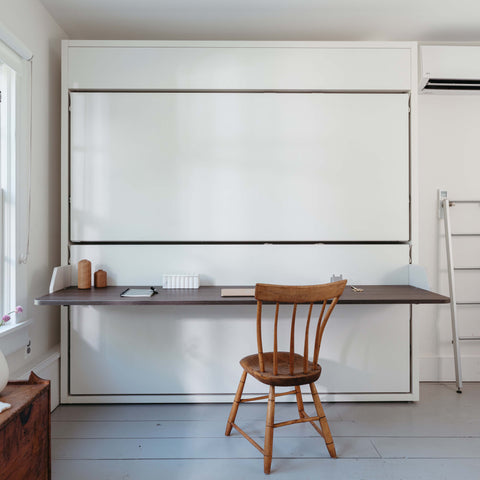
Wall beds work in almost any room. They can transform an office, spare room or even a dining room into a multifunctional area to maximize space. With so many design options, the wall bed seems like a normal part of the room, so your dining room still looks like a dining room rather than looking like a bedroom. Having a hard time imagining wall bed design plans in different rooms? Check out these room options and integration tips:
Office: Adding a wall bed to your office is an ideal way to get the most out of the space. You likely only use the office space for work during the day. At night, pull down the Murphy bed to create a sleeping area for yourself or guests. You retain a dedicated workspace while adding a bed. Maximize a small office space by choosing a wall bed with an integrated desk. The bed folds down over the desk without your having to remove anything from the surface.
Living Room: Instead of a clunky sofa bed, integrate a wall bed into your living room. In a loft or studio apartment, this option creates a bedroom area that is easy to tuck away during the day. You don’t have to take up a chunk of the living space with a traditional bed or use panels to hide the bed.If you want to combine seating and sleeping quarters, install a modern Murphy bed design with an integrated sofa. You get the living room seating during the day and a bed at night. Another option is a wall bed with integrated shelving for display space.
Dining Room: Your dining area may not seem to be a likely option for your bed, but modern wall bed designs make it a seamless integration. That’s because some wall bed designs offer the option of incorporating a table into the design. During the day, the setup serves as a dining table, which can also work for crafts, homework and other activities that require a flat surface. At night, the system folds down into a bed. This option is ideal as a guest bed or even as your regular bed when space is limited.
Kids’ Room or Playroom: Give your kids more play space by installing a Murphy bed in a bedroom or playroom. This sleeping option solves the space shortage issue in a small child’s bedroom. During the day, the bed folds up against the wall to give your child plenty of floor space for playing. At night, the bed easily comes down into position for comfortable sleep. In the playroom, install a wall bed to make the space double as a guest room. This option is a simple solution when you want a sleeping area for guests, but you also need the play space on a daily basis for your kids. Opt for a Murphy bed with integrated shelving, so you can store baskets of toys on them. Another option is a wall bed with a built-in sofa to add seating in the playroom. Sit in the space while your kids play, or sit together to read books.
Multi-Use Guest Bedroom: If you have a guest room, a wall bed is an ideal way to make the space more functional for times when you don’t have guests. Use the space as an office, sitting room, craft room or other functional space on a day-to-day basis. When guests arrive, fold the bed down to create private sleeping quarters for their stay. It’s a great way to get more use out of one space while still having a dedicated bed for your guests. They’ll appreciate sleeping on a real mattress instead of a sofa bed or air mattress.
Popular posts

Aging in Place That Actually Feels Like Home

Does Converting a Garage to a Living Space Add Value? What to Know Before You Start

Multifunctional Kids' Room by YZDA at Armani Casa Miami

When Every Inch Counts: A Multifunctional Retreat in Cobble Hill
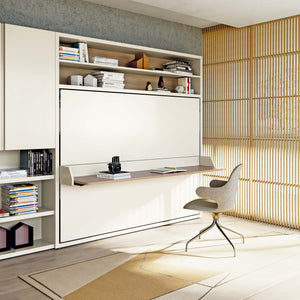
10 Bonus Room Ideas: What To Do With Your Extra Space


